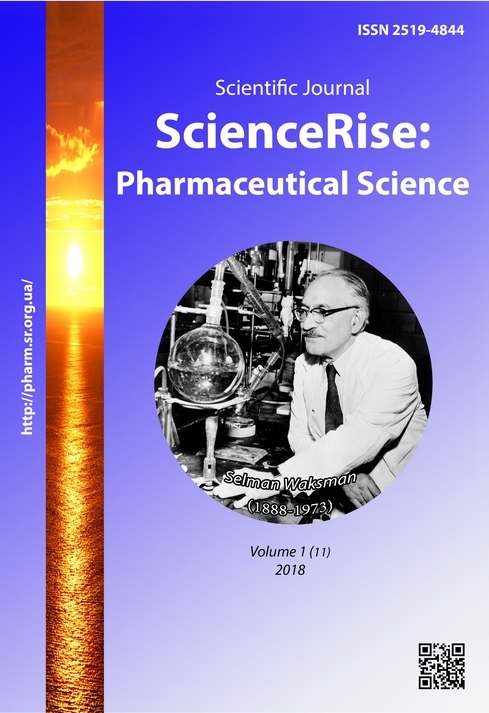The synthesis and study of profiles of the ornidazole impurities
DOI:
https://doi.org/10.15587/2519-4852.2018.123387Keywords:
ornidazole impurities, synthesis, ornidazole-diol, ornidazole-epoxide, profile of impurities, ornidazole substance, infusion solution of ornidazole, pharmacopoeial reference standards, State Pharmacopeia of UkraineAbstract
Pharmacopoeial reference standards (PhRSs) provide the comparability of the test results of generic drugs. PhRSs of ornidazole impurities are not described in pharmacopoeias. Therefore, the establishment of PhRSs of the State Pharmacopeia of Ukraine (SPhU RSs) of ornidazole impurities is an essential task, the integral part of which is synthesis and characterisation of ornidazole impurities.
Aim: To synthesise impurities of ornidazole as candidate materials for certification as SPhU RSs and study their profiles in the substance and infusion solution of ornidazole.
Methods: Traditional methods of organic synthesis, 1Н NMR spectroscopy, IR absorption spectrophotometry, the capillary method for the melting point determination, liquid chromatography with a spectrophotometric detector.
Results: Ornidazole-diol and ornidazole-epoxide were synthesized, and their structures were confirmed using 1Н NMR and IR spectra. Their chromatographic profiles in the substance and the infusion drug of ornidazole being under pharmaceutical development were studied. The problem with the ornidazole-diol determination by the manufacturer’s procedure was found, and its correction was proposed. The purity of the compounds synthesized was approximately 99.5 %. In the substance, the content of ornidazole-epoxide exceeded 0.1 %, whereas the content of ornidazole-diol was negligible. In the drug, the content of ornidazole-epoxide reduced to zero with time, while the content of ornidazole-diol increased considerably (to approx. 3 %).
Conclusions: The efficient methods for the synthesis of ornidazole-epoxide and ornidazole-diol were developed, and the synthesis was conducted. The profiles of the synthesized impurities in the substance and the infusion drug of ornidazole being under pharmaceutical development were studied. It was found that ornidazole-epoxide and ornidazole-diol are present in the substance and the drug at the level which requires their identification and quantitative determination. The proposed methods for synthesis provide obtaining ornidazole-diol and ornidazole-epoxide of high purity, which enables to use them as the candidate materials for certification as SPhU RSs
References
- Kovalenko, V. N. (2016). Kompendium 2016 – lekarstvennyie preparatyi. Kyiv: MORION, 2416.
- Bobrytska, L. O., Nazarova, O. S., Verbova, Yu. M. (2012). Rozrobka ta validatsiia metodyky kilkisnoho vyznachennia tabletok z Ornidazolom. Upravlinnia pravlinnia, ekonomika konomika ta zabezpechennia zabezpechennia yakosti v farmatsii, 3 (23), 9–14.
- Hizarciolu, Y. S., Zeynep, A. Y., Ozyazici, M. (2004). Bioavailability File: Ornidazole. FABAD Journal of Pharmaceutical Sciences, 29 (3), 133–144.
- Breccia, A., Cavalleri, B., Adams, G. E. (Eds.) (1982). Nitroimidazoles: Chemistry, Pharmacology, and Clinical Application. New York: Plenum Press, 209. doi: 10.1007/978-1-4684-4151-2
- Soares, M. F. de L. R., Soares-Sobrinho, J. L., da Silva, K. E. R., Alves, L. D. S., Lopes, P. Q., Correia, L. P. et. al. (2011). Thermal characterization of antimicrobial drug ornidazole and its compatibility in a solid pharmaceutical product. Journal of Thermal Analysis and Calorimetry, 104 (1), 307–313. doi: 10.1007/s10973-010-1185-y
- Leontiev, D. A., Volovyk, N. V., Gryzodoub, A. I. (2013). Sistema farmakopeinyh standartnyh obrazcov Gosudarstvennoi Farmakopei Ukrainy: koncepciya sozdaniya i tekushchee sostoyanie. Farmacevticheskii zhurnal (Uzbekistan), 2, 29–37.
- European Pharmacopoeia (2017). Strasbourg: European Department for the Quality of Medicines. Available at: https://www.edqm.eu/en/european-pharmacopoeia-9th-edition
- The United States Pharmacopoeia. USP 41–NF 36. Rockville: The United States Pharmacopeial Convention. Available at: http://www.uspnf.com
- British Pharmacopoeia (2017). Available at: https://www.pharmacopoeia.com/BP2017
- Wang, Y., Zhang, C., Tao, X. (2013). Pat. 20130202698 A1 US. L-ornidazole formulations and their applications in treatment of parasitic infections. No. US 13/831,706; declareted: 15.03.2013; published: 08.08.2013. Available at: www.google.com/patents/US20130202698
- ICH Harmonized Tripartite Guideline: Q3A (R2) Impurities in New Substances (2006). The International Conference on Harmonisation of Technical Requirements for Registration of Pharmaceuticals for Human Use (ICH), 15.
- CH Harmonized Tripartite Guideline: Q3B (R2) Impurities in New Drug Products. (2006). The International Conference on Harmonisation of Technical Requirements for Registration of Pharmaceuticals for Human Use (ICH), 14.
- Belousova, O. V., Belousov, E. A., Kubrak, N. G. (2017). Analiz potrebleniya protivoparazitarnyih lekarstvennyih preparatov v aptechnyih organizatsiyah. Nauchnyiy rezultat. Meditsina i farmatsiya, 3 (2), 20–26.
- TLC Pharmaceutical Standards Ltd. Available at: http://tlcstandards.com
- Chemical book. Available at: http://www.chemicalbook.com
- Young standarts. Available at: http://yongstandards.com
- LGC Standards. Available at: https://www.lgcstandards.com
- The Indian Pharmacopoeia (2014). Ghaziabad: The Indian Pharmacopoeal Commission, 2385–2387.
- Bakshi, M., Singh, B., Singh, A., Singh, S. (2001). The ICH guidance in practice: stress degradation studies on ornidazole and development of a validated stability-indicating assay. Journal of Pharmaceutical and Biomedical Analysis, 26 (5-6), 891–897. doi: 10.1016/s0731-7085(01)00475-7
- Salo, J. K., Yli‐Kauhaluoma, J., Salomies, H. (2003). On the hydrolytic behavior of tinidazole, metronidazole, and ornidazole. Journal of Pharmaceutical Sciences, 92 (4), 739–746. doi: 10.1002/jps.10349
- He, J., Zhu, P., Zheng, G. (2012). Characterization of major impurity in ornidazole and sodium chloride injection. Chinese Journal of Pharmaceutical Analysis, 32 (10), 1822–1825.
- Ping, H. (2013). Pat. 102552127 B CN. Ornidazole injection. No. CN 201210021254; declareted: 31.01.2012; published: 11.12.2013. Available at: https://www.google.com/patents/CN102552127B?cl=en
- Leontyev, D. A., Volovyk, N. V., Bevz, O. V., Denysenko, N. V., Gudz, N. I., Gella, I. M. (2017). Vyvchennya mozhlyvosti farmakopeinoyi standartyzaciyi produktiv degradaciyi Ornidazolu. Upravlinnya yakistyu v farmaciyi. Kharkiv: Vydavnytstvo NFAU, 102–103.
- Skupin, R., Cooper, T. G., Frohlich, R., Prigge, J., Haufe, G. (1997). Lipase-catalyzed resolution of both enantiomers of Ornidazole and some analogues. Tetrahedron: Asymmetry, 8 (14), 2453–2464. doi: 10.1016/s0957-4166(97)00260-7
- Hoffer, M., Grunberg, E. (1974). Synthesis and antiprotozoal activity of 1-(3-chloro-2-hydroxypropyl)-substituted nitroimidazoles. Journal of Medicinal Chemistry, 17 (9), 1019–1020. doi: 10.1021/jm00255a026
- Suwinski, J., Rajka, A., Watras, J., Widel, M. (1980). Nitroimidazole. Acta Poloniae Pharmaceutica, 37 (1), 59–67.
- Derzhavna Farmakopeya Ukrayiny. Vol. 1 (2015). Kharkiv: Derzhavne pidpryiemstvo «Ukrainskyi naukovyi farmakopeinyi tsentr yakosti likarskykh zasobiv», 1128.
Downloads
Published
How to Cite
Issue
Section
License
Copyright (c) 2018 Dmytro Leontiev, Olena Bevz, Natalia Volovyk, Ivan Gella, Victoria Georgiyants

This work is licensed under a Creative Commons Attribution 4.0 International License.
Our journal abides by the Creative Commons CC BY copyright rights and permissions for open access journals.








